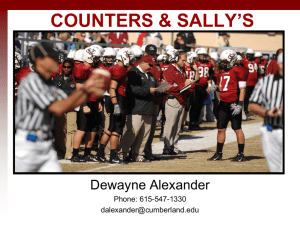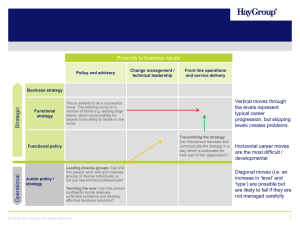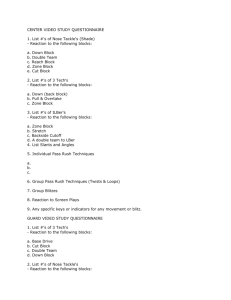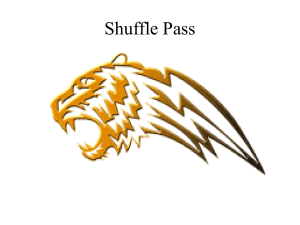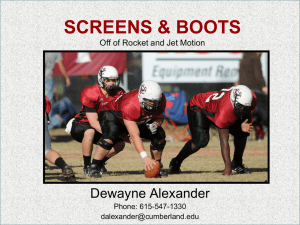Complimenting the Inside Zone with the Wham My name is Kyle
advertisement
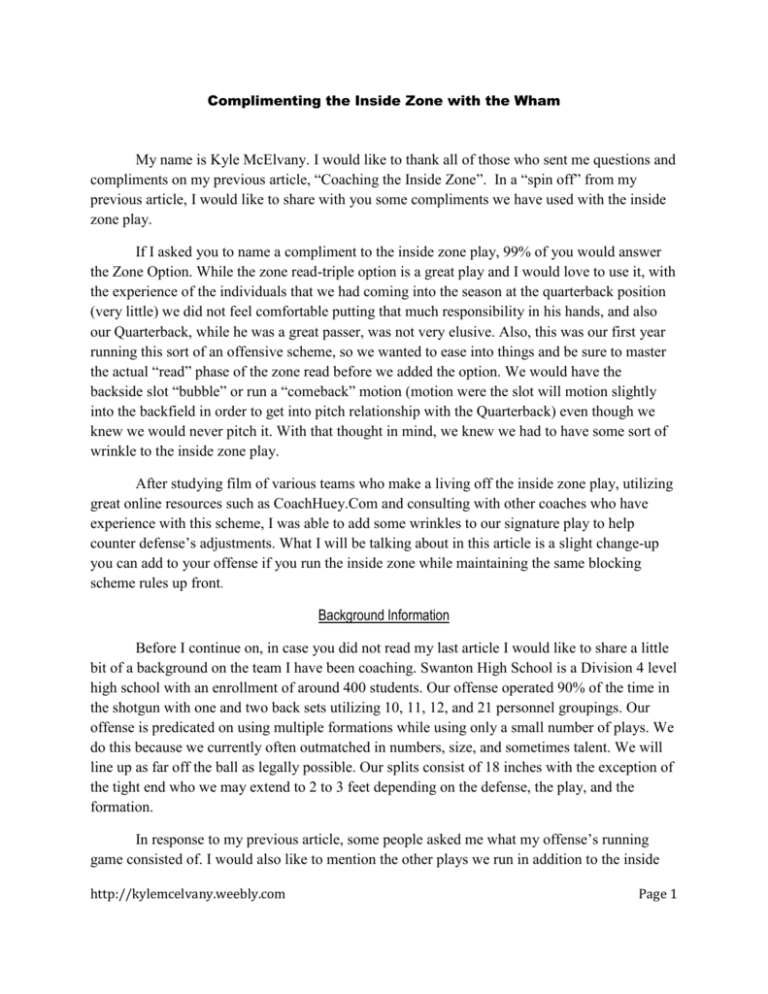
Complimenting the Inside Zone with the Wham My name is Kyle McElvany. I would like to thank all of those who sent me questions and compliments on my previous article, “Coaching the Inside Zone”. In a “spin off” from my previous article, I would like to share with you some compliments we have used with the inside zone play. If I asked you to name a compliment to the inside zone play, 99% of you would answer the Zone Option. While the zone read-triple option is a great play and I would love to use it, with the experience of the individuals that we had coming into the season at the quarterback position (very little) we did not feel comfortable putting that much responsibility in his hands, and also our Quarterback, while he was a great passer, was not very elusive. Also, this was our first year running this sort of an offensive scheme, so we wanted to ease into things and be sure to master the actual “read” phase of the zone read before we added the option. We would have the backside slot “bubble” or run a “comeback” motion (motion were the slot will motion slightly into the backfield in order to get into pitch relationship with the Quarterback) even though we knew we would never pitch it. With that thought in mind, we knew we had to have some sort of wrinkle to the inside zone play. After studying film of various teams who make a living off the inside zone play, utilizing great online resources such as CoachHuey.Com and consulting with other coaches who have experience with this scheme, I was able to add some wrinkles to our signature play to help counter defense’s adjustments. What I will be talking about in this article is a slight change-up you can add to your offense if you run the inside zone while maintaining the same blocking scheme rules up front. Background Information Before I continue on, in case you did not read my last article I would like to share a little bit of a background on the team I have been coaching. Swanton High School is a Division 4 level high school with an enrollment of around 400 students. Our offense operated 90% of the time in the shotgun with one and two back sets utilizing 10, 11, 12, and 21 personnel groupings. Our offense is predicated on using multiple formations while using only a small number of plays. We do this because we currently often outmatched in numbers, size, and sometimes talent. We will line up as far off the ball as legally possible. Our splits consist of 18 inches with the exception of the tight end who we may extend to 2 to 3 feet depending on the defense, the play, and the formation. In response to my previous article, some people asked me what my offense’s running game consisted of. I would also like to mention the other plays we run in addition to the inside http://kylemcelvany.weebly.com Page 1 zone play. Our running game consists of Counter G.T. (either halfback or quarterback), Inside Zone, Outside Zone (ran as either a Jet Sweep or Toss), Speed Option, and Trap. We are also a “no-huddle” team. The Wham After doing research on different ways to counter defense’s adjustments to the inside zone play, in particular defenses attacking the A gaps with a shaded nose guard or 1 technique, which we had the most problems with. A fellow coach had told me about the concept of the wham which was a staple in Joe Gibbs’s Washington Redskins teams and is still used by many N.F.L. teams today. From what information I have gathered, it was first used by Dan Henning who worked under Gibbs as an Assistant Head Coach/Quarterbacks coach and eventually Offensive Coordinator. Henning would go on to spend time with other N.F.L. teams and now is the Offensive Coordinator for the Miami Dolphins. You can find an image of this play in 1992 Washington Redskins playbook floating around the internet underneath the name “40/50 Lead Nose”. For the purposes of keeping things simple for the players, we called the play Zone “Nose” if we wanted to wham the nose guard or backside 1 technique or Zone “End” if we wanted to wham the end man on the line of scrimmage on the backside of the play. We will use this play in both our shotgun and under-center formations. The naked play action off of this look is great as well. In figure 1 below, you will see what we call 43/44 Zone “Nose” out of the 21 personnel formation we call Try Nasty against how a particular opponent of ours operating out of a 33 stack adjusted to the formation. I consider Zone “Nose” to be the more difficult of the wham variations to install. In the situation below, if were running the play to the right side, starting on the play side, the Tight End (Y) will make a “solo” call and base block the defender. Nothing changes for the Right Tackle and Right Guard as they will combo the defensive tackle to up to the play side linebacker. Since the nose guard is shaded to the strength, this becomes easier for the center. Depending on how far shaded the nose guard is, the center can either take a short lateral step to the backside then go immediately to the 2nd level and look for the first defender he sees from the back side or simply rip past the defender. A couple key coaching points for the center is for him to look pre snap where the first possible back side 2nd level defender is and once he is engaged with a defender; he must remain engaged through the echo of the whistle because he may very well be the key block in the “cutback” lane of the tailback. The center also has the responsibility of making the call to the left guard telling him we are not blocking the nose guard. The right guard will still take his “uncovered” step which is a lateral step then continue on his vertical path picking up any defenders who may cross his face. Since the backside defensive tackle is threatening the left tackle’s play side gap, he will take a reach (45 degree angle) step, getting to his aiming point on the defender and attempt to get a vertical push on him. More often than not, the tackle will end up blocking the defender down creating that cutback lane. The Hhttp://kylemcelvany.weebly.com Page 2 Back will align 3 feet away from the tackle and 3 feet deep in the backfield, in a 2 point stance, facing forward. Some coaching points for the H Back is to stay close to the butt’s of the linemen and when he is kicking out the defender, to keep his head on the inside, using his forearm and shoulder as the primarily blocking surface. We want the H-Back to run THROUGH the defender and not just “to” him. The only problem we have had running this play is when we play a 3-3 stack defense and they do not bump the linebackers over to the strength to cover the H-Back. To counter that problem, we will have the backside tackle release immediately to the 2nd level, the backside guard will also release to the 2nd level to pick up the first defender that would threaten his gap, and the center would snap then pull backside and kick out the end man line of scrimmage on the backside of the play. Fortunately for us, we felt our center was smart and talented enough to pull off snapping then pulling. It took a lot of reps both before and during practice for the center to get comfortable snapping then pulling without messing up the snap. Nothing changes for the play side guard and tackle as would use their normal blocking rules for the inside zone play. When I was installing this play into the offense, I had the tailback watch the offensive line block the play against the defense without a ball carrier so he could understand where the possible running lanes would be. It will most likely end up being a play side A gap play. For a better visual explanation of this adjustment, see figure 2 below. The easier install of the two wham variations is what we called Zone “End” in which the H-Back was responsible for kicking out the back side end man on the line of scrimmage. This version of the wham is used quite often by N.F.L. teams today. In the New England Patriots playbooks floating around the internet, it is under the name of “33/34 Bend”. Virginia Tech also used this play quite a bit in their Orange Bowl game against the Cincinnati Bearcats. Nothing changes in regards to assignments for the offensive linemen unless the backside tackle has an inside shaded defender, which in that situation he would automatically release to the 2nd level if http://kylemcelvany.weebly.com Page 3 that defender was the end man on the line of scrimmage. Depending on the speed of the tailback, we will sometimes set the tailback back a little farther to set up the timing for a better cutback lane. See figure 3 for visual explanation. I have also called the wham play while using unbalanced formations and off of jet motion. In the play shown in figure 4 below, we are running Zone “Nose” out of an unbalanced formation we call Try Right Wing Over. The blocking scheme is primarily the same for Tight End, Right Tackle, Right Guard, and Center on this play. Since he has a 1 technique lined up on him who will be the one getting kicked out by the H-Back, the left guard will immediately release to the 2nd level to pick up the first defender that comes on his path. The left tackle will also has the same responsibility as normal, since he is covered, he will take a lead step and attempt to get vertical movement. It is very important for the left tackle in this situation to block through the whistle and not let anything cross his face. The Quarterback will give a flash fake to the sweeper than open at about approximately 3’o clock and give the ball to the tailback. It is important for the tailback to take a jab step before he continues on his path aiming at the crack of the guard. Figure 4 http://kylemcelvany.weebly.com Page 4 Play Action Passing As I said earlier, the naked play action off of this play was great for us this year, particularly on goal line and short yardage situations. In figure 5 below, is what we call 44 Zone Naked out of a 21 Personnel Set we call Try Right Wing. Pass blocking wise, we tell the linemen to sell inside zone for 3-4 steps. We want them to come off the ball and attack the defense as if we were running the football. They should be keeping their elbows in, maintaining a low pad level and block for 5 seconds. In the play below, we will have the X (split end) receiver run a vertical comeback route at approximately 18 yards. The Tight End (Y) will count 1001, 1002 then inside release, gaining depth and work across the field no deeper than 12 yards on a drag route. At the snap, the H-Back will come underneath the formation and he is assigned to the flat while the back side #1 receiver will run a post. The Quarterback will open at 5’o clock if he is booting to the left and 7’o clock if booting to the right. The tailback’s goal is to sell the handoff so well that he gets tackled. If the Quarterback reads a blitz coming by the defense during presnap, he will make a call to the receivers and tailback that will tell them that he is shortening the fake to the tailback and that the receivers need to shorten their routes. Figure 5 Closing Thoughts I hope this article can give you an idea or two that you can use for your offense. I would also like to thank Coach Ed Kaman from Godwin Heights High School in Michigan who gave me the idea to research the wham play and Coach Bill Mountjoy who also provided me with some information. I believe you can add this play to your offense even if you do not run a zone blocking scheme. I am always looking for new ideas for not just the inside zone play but offense in general. If you have any questions or comments feel free to contact me at kmcelvany@comcast.net . http://kylemcelvany.weebly.com Page 5
